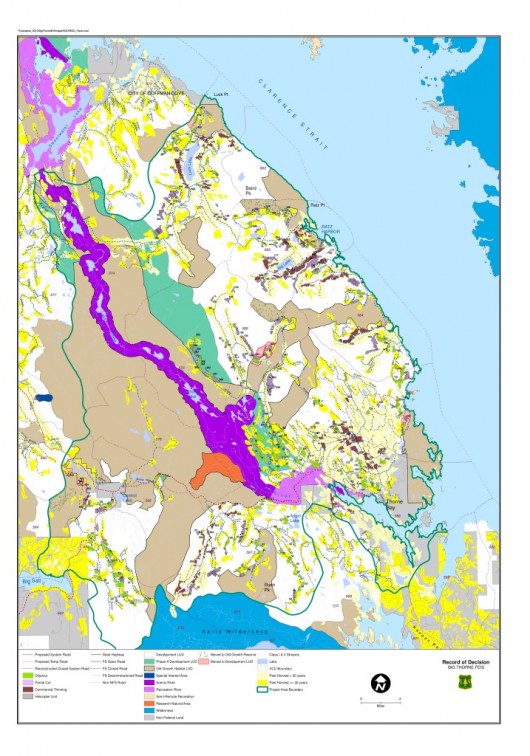 The U.S. Forest Service issued its Final Supplemental Information Report for the Big Thorne Timber Sale this week, upholding its Record of Decision.
The U.S. Forest Service issued its Final Supplemental Information Report for the Big Thorne Timber Sale this week, upholding its Record of Decision.
The Supplemental Information Report, or SIR, from Tongass National Forest Supervisor Forrest Cole was prompted by appeals to last year’s Record of Decision, and a letter from a retired biologist who brought up concerns over wolf populations in the harvest area.
“There was some information that was provided that wasn’t available when we signed the ROD, or did the EIS,” he said.
That’s Forrest Cole, who said that Regional Forester Beth Pendleton asked him to review the information in that letter with the goal of answering these questions: “Did we implement (the decision) correctly and did we see any new information that we should consider through the SIR process, and either adjust the ROD or leave it as it was?”
Cole said the conclusion is that there’s no new information that had been left out of the analysis. He acknowledges concerns over wolf populations, though. To address those concerns, Cole decided to defer offering some portions of the harvest area.
That doesn’t necessarily take those sections off the table, though.
“We may offer them at a later date, or may just hold them and change the decision at a later date,” he said.
Cole said the best way to help wolf populations thrive is through hunting and trapping regulations and enforcement. He cites studies that show 87 percent of wolves killed on Prince of Wales Island were from those activities.
Cole said state and federal fish and game officials were involved in the SIR process, and they are working on stricter regulations for wolf hunting.
There was another issue raised after the ROD comment period closed, however, that was not addressed in the SIR. In July of this year, the Juneau office of Earthjustice, an environmental law organization, sent a letter to Cole regarding the Lesser Round-Leaved Orchid.
According to the letter, studies show that 73 percent of the orchids that exist in the world live within the Big Thorne project area. The letter argues that the Forest Service failed to disclose information about the orchid.
Cole said he’s aware of the letter, and that the orchid issue was part of the Environmental Impact Statement.
“They have claimed that it was new information and it may have been for them,” he said. “But I was aware of it through the Environmental Impact Statement analysis process.”
The Big Thorne Timber Sale project area covers more than 200,000 acres on Prince of Wales Island close to Thorne Bay and Coffman Cove. The proposed harvests would include more than 6,000 acres of old-growth forest, and more than 2,000 acres of second-growth.
Of the old-growth area targeted for harvest, about 3,700 acres would be clear-cut; and about 2,400 acres would be partially harvested, leaving 50 to 75 percent of trees standing.
Daven Hafey is the communications director for the Southeast Alaska Conservation Council, a regional environmental group. He said SEACC believes that the Big Thorne Timber Sale is misguided.
“We support increasing the number of jobs per log cut on the Tongass, rather than shipping half the logs cut on the Tongass overseas,” he said. “The Big Thorne will export long-term jobs for short-term profits, and it will do so at an unsustainable rate and that’s not progress.”
Hafey said that SEACC is concerned about the cumulative effects of old growth timber harvest on deer populations. He said hunters in the area would see reduced availability.
“The Forest Service admits that they likely will have significant restrictions in subsistence uses of deer,” he said. ”That’s not something we’re going to give up on. We advocate pretty strongly for deer habitat.”
Hafey said that SEACC intends to file a lawsuit in hopes of halting the sale.
Cole said he expected that.
“There is a lot of controversy around this project,” he said. “There’s a lot of folks that have pretty strong opinions about the timber industry and old-growth timber harvests.”
The Forest Service is working toward changing the timber industry on the Tongass, to focus more on second-growth harvests. Cole said moving in that direction could mean less time taken up by appeals and lawsuits.
Harvesting in areas that already were logged previously would not only be less controversial, it would be easier on everyone.
“The roads are in place, pretty much all the work has been done in terms of how to log them and when to log them,” he said. “So, theoretically the ground has already been impacted once and we may be able to go into a more streamlined environmental analysis process.”
Cole said the Forest Service has been successful on a couple of young growth projects on the Tongass, and another is in the works.





